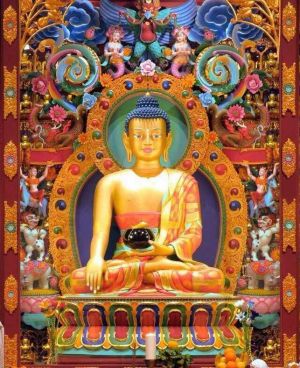Atiśa (Dipaṃkara, Tib. Jo-bo-rje, 982-1054 CE)
Atiśa (Dipaṃkara, Tib. Jo-bo-rje, 982-1054 CE)
Indian Mahāyāna Buddhist scholar-saint who revitalized Buddhism in Tibet during the early 11th century.
According to Tibetan tradition, Atiśa was born in western Bengal of a royal family. He
was considered a prodigy, mastering Sanskrit and other literary skills at a young age. From his
youth he was guarded and influenced by the goddess Tārā, perhaps an indication of the Tantric practices and affiliations he may have had in his adolescent years. He took monastic vows at the
age of twenty-nine in a monastery at Bodh Gayā, the site of the Buddha’s enlightenment. Atiśa
mastered the monastic curriculum of his time, studying among other topics, ethics (vinaya), logic
and epistemology (pramāṇa), and middle way philosophy (madhyamaka).
In addition to studying these lineages of teaching available in India in the eleventh century,
Atisha traveled to Indonesia and studied there for twelve years under the Mahayana Buddhist master Suvarnadvipa, a.k.a. Dharmakīrti-śrī. Atisha received from this teacher the quintessential
oral transmission lineage known as lojong (Tib. blo sbyong), which translates as “training the mind.” This lineage, emphasizing cultivations on love and compassion, fused with his emphasis
on cultivating the “thought intent on enlightentment (Skt. bodhicitta),” would become Atiśa’s
greatest contribution to Indian and Tibetan Buddhism.
Atiśa was invited to Tibet to revive and reform the Buddhist teachings that had been
diminished by the persecutions of the anti-Buddhist Tibetan king Lang Darma. Although warned
by his patron deity Tārā that traveling to Tibet would shorten his life, his arrival in western Tibet
Apple_Atiśa Dīpaṃkaraśrījñāna.doc
in 1042 is regarded as one of the greatest events in the history of Tibetan Buddhism.
Atiśa’s composition of the Lamp for the Path to Enlightenment (bodhi-patha-pradīpa)
embodies in a succinct but complete manner the style of Buddhist practice that he advocated for
the Tibetan people. This manual presents the ‘gradual stages to enlightenment’ (lam-rim)
instructional lineages of the profound view of emptiness and the vast deeds of practice. In this
text, Atisha indicates that the best religious life is that of a celibate Mahāyāna monk who
diligently adheres to the monastic code and follows the gradual path to enlightenment for the
benefit of all beings. Atiśa’s instructions and influence led to the founding of the Kadampa order,
the first school of Buddhism in Tibet. Atisha died in Tibet at Nye-thang (snye-thang) just south of Lha-sa where his relics are enshrined in a temple.
James B. Apple
References and futher reading
Chattopadhyaya, Alaka. 1967. Atisa and Tibet: Life and works of Dipamkara Srijñana in relation to the history and religion of Tibet : With Tibetian sources transl. under Lama Chimpa. Calcutta: Indian Studies. Past & Present. Sherburne, Richard, trans. 2000. The Complete Works of Atisa Sri Dipamkara Jnana, Jo-bo-rje : The Lamp for the Path and commentary, together with the newly translated twenty-five key texts (Tibetan and English texts). New Delhi : Aditya Prakashan. Sonam, Ruth, trans. and ed. 1997. Atisha's Lamp for the Path: an oral teaching by Geshe Sonam Rinchen. Ithaca, N.Y.: Snow Lion Publications.
